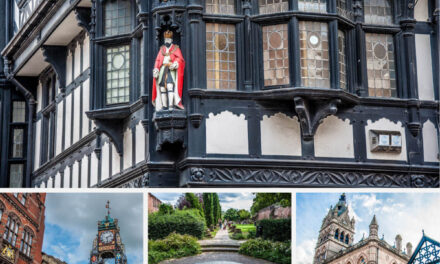LIVERPOOL
Normally, Liverpool is a vibrant, multi-cultural city that is known throughout the world as a major industrial force, and, in more recent years, as the birthplace of the world-famous music group the Beatles and also because of the celebrated football teams Everton F.C. and Liverpool F.C.
Liverpool has a hugely interesting history some of which we will now consider:
In the sixteenth century, its population was around 500 and the original street plan was designed by King John and laid out by seven streets which made up a H shape.
It is situated on the eastern side of the Mersey Estuary and became a city in 1880. During the Industrial Revolution, the port became more important as it handled many things like coal, cotton, freight, general cargo and, infamously, it played a part in the slave trade.
Interestingly, there were battles to take control of what was then a town, during the English Civil War which included an 18-day siege in 1644.
It is true to say that following the construction of the first commercial dock in 1715, profits from tobacco and the slave trade helped the town to prosper – which was reflected in the construction of many major buildings. It is also important to add however, that three local men campaigned for the abolition of the slave trade: Edward Rushton, William Rathbone and William Roscoe.
Liverpool also hugely prospered in the nineteenth century as a large volume of trade was passing through it. Through the Liverpool and Manchester Railway, Liverpool and Manchester became the first cities to have an intercity rail link.
Not surprisingly, the wealth of the city was greater than that of even London during periods of the nineteenth century.
Significantly, in the 1840s hundreds of thousands of Irish migrants began arriving in Liverpool due to the Great Famine. Also, in the late nineteenth and early twentieth century, many immigrants arrived from Europe and, consequently, influenced the religious and social makeup of Liverpool, which is reflected by the diversity of its religious architecture.
Following the end of the First World War, the city experienced great social unrest as society tried to cope with the loss of young men whilst also, trying to accommodate veterans in the economy. Some colonial soldiers and sailors from India and Africa who had served the UK also settled in cities like Liverpool and, in June 1919, the country witnessed race riots. However, Liverpool also became home to a large West Indian black community and to some commonwealth immigrants who settled in poorer areas like Toxteth.
Happily, in the sixties, Liverpool became world-famous due to the emergence of the “Merseybeat” which included bands like the Beatles and Gerry and the Pacemakers – in 2002, the city’s airport was renamed after the murdered Beatle John Lennon.
Unfortunately, from the mid-1970s onwards, Liverpool docks and industry declined resulting in huge unemployment in the city, in the 1980s. But, in the late twentieth century, Liverpool’s economy revived and there was regeneration in the city.
In the twenty-first century, tourism has become very important to the city with promotion of its many popular music acts like the Beatles, world-class art galleries, museums and landmarks. Importantly, property developer Grosvenor developed Liverpool city centre through a project named ‘Liverpool One’, which opened in May 2008.
Many people may be unaware what a social trailblazer the city has actually been – it was the first to have a School for the Blind, high schools for girls, council houses and Juvenile court. It also introduced the district nurse, slum clearance, a cancer research centre and free school milk and meals – and much more!
Culturally, Liverpool is very rich e.g. it is home to the Royal Liverpool Philharmonic Orchestra and to the Liverpool Playhouse which is the oldest surviving repertory theatre. It was also the birthplace of inventor Frank Hornby who introduced us to toys like: Meccano, Hornby Model Railways and, of course, Dinky Toys!
If you appreciate horse racing, it would be unforgiveable not to mention The Grand National which usually takes place annually at Aintree Racecourse on the outskirts of the city, and which is watched by millions of people around the world.
Natives to Liverpool are known as Liverpudlians and colloquially as “Scousers” which refers to a form of stew called ‘Scouse’. You will not meet warmer, more hospitable people than “Scousers”, so if you have the chance, visit this lovely northern city that is Liverpool!
* With a lot of help from Wikipedia
If you want to visit more places then look at Dean’s Places on this website



Recent Comments